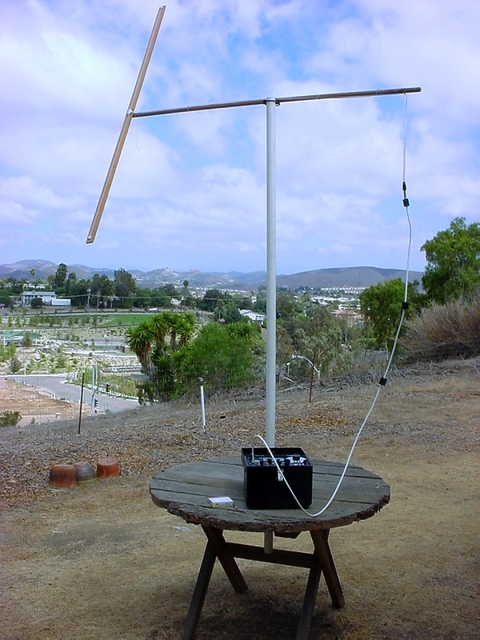

I used this test setup to measure the axial ratio of circularly polarized FM broadcast signals. A piece of wood supports a folded dipole whose tilt angle I varied with a stick. The boom is wood and the mast is PVC. Twinlead with an integral 300Ω balun connects to a few feet of RG-6. Three ferrite chokes suppress coax shield current. The center of the dipole is 99″ above ground. The black box is a Wavetek SAM, a portable RF level meter.
I made the measurements from a hilltop 700 feet above sea level seven miles from the coast in northern San Diego County. I measured signals from San Diego, the greater Los Angeles area, and Santa Barbara. The horizon to the south is a range of low hills a few miles away. From north to northwest it is a mountain range 17–26 miles away. To Santa Barbara it is the ocean. Reflections were possible from hills in other directions and from my house, but nothing nearby obstructed signals.
With the antenna horizontal I rotated the mast for maximum signal. Then I adjusted the tilt from −90° to +90° and recorded the maximum variation in RF level. I didn't record the tilt angle for maximum signal, but it varied greatly. Finally, I calculated two gain figures from the measured axial ratio.
Station Frequency Distance Bearing Axial Ratio Typical Gain Maximum Gain
MHz miles deg dB dB dB
KKJZ 88.1 71 310 2 2.1 2.1
KSBR 88.5 34 318 8 -0.1 0.6
KUSC 91.5 89 327 4 1.2 1.5
KDB 93.7 168 304 4 1.2 1.5
KMYI 94.1 21 186 7 0.2 0.8
KFRG 95.1 73 357 5 0.9 1.2
KLOS 95.5 90 327 1 2.5 2.5
KSON 97.3 30 164 4 1.2 1.5
KLYY 97.5 76 3 6 0.5 1.0
KIFM 98.1 21 186 6 0.5 1.0
KOLA 99.9 57 356 1 2.5 2.5
KIOZ 105.3 21 186 7 0.2 0.8
KALI 106.3 56 319 6 0.5 1.0
KWVE 107.9 43 335 5 0.9 1.2
Average 4.7 1.0 1.4
Typical gain is for a receive antenna with an axial ratio of 0 dB. Maximum gain is for a receiver that combines the orthogonal signals with optimal weighting coefficients. The gain reference is the signal level along the major axis of the polarization ellipse. If the antenna consists of crossed Yagis, this is the response of a single Yagi when tilted for maximum signal.
To estimate the gain over a single horizontal Yagi, assume that the signal tilt angle is randomly distributed. A stochastic simulation using the measured axial ratios yielded an average response 2.5 dB below the major-axis response. So for the signals I measured, typical gain of circularly polarized crossed Yagis over a single horizontal Yagi should average 3.5 dB and maximum gain should average 3.9 dB.

KWVE in Orange County was the only station within line of sight. This elevation profile to the tower illustrates the terrain irregularity and the many opportunities for signal diffraction. Each can differentially alter the orthogonal fields and contribute to polarization noncircularity. The vertical scale exaggerates by a factor of five.
 88–108 MHz
88–108 MHz